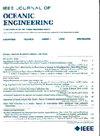Object Modeling From Underwater Forward-Scan Sonar Imagery With Sea-Surface Multipath
IF 3.8
2区 工程技术
Q1 ENGINEERING, CIVIL
引用次数: 0
Abstract
In this article, we propose an optimization technique for 3-D underwater object modeling from 2-D forward-scan sonar images at known poses. A key contribution, for objects imaged in the proximity of the sea surface, is to resolve the multipath artifacts due to the air–water interface. Here, the object image formed by the direct target backscatter is almost always corrupted by the ghost and sometimes by the mirror components (generated by the multipath propagation). Assuming a planar air–water interface, we model, localize, and discard the corrupted object region within each view, thus avoiding the distortion of recovered 3-D shape. In addition, complementary visual cues from the boundary of the mirror component, distinct at suitable sonar poses, are employed to enhance the 3-D modeling accuracy. Optimization is implemented as iterative shape adjustment by displacing the vertices of triangular patches in the 3-D surface mesh model, to minimize the discrepancy between the data and synthesized views of the 3-D object model. To this end, we first determine 2-D motion fields that align the object regions in the data and synthesized views, then calculate the 3-D motion of triangular patch centers, and finally determine the model vertices. The 3-D model is initialized with the solution of an earlier space-carving method applied to the same data. The same parameters are applied in various experiments with two real data sets, a mixed real-synthetic data set, and computer-generated data guided by general findings from a real experiment, to explore the impact of nonflat air–water interface. The results confirm the generation of a refined 3-D model in about half-dozen iterations.海面多路径水下前向扫描声纳图像目标建模
在本文中,我们提出了一种基于已知姿态的二维前向扫描声纳图像的三维水下目标建模优化技术。对于在海面附近成像的物体,一个关键的贡献是解决由于空气-水界面造成的多路径伪影。在这里,由直接目标反向散射形成的物体图像几乎总是被鬼影破坏,有时被镜像组件(由多路径传播产生)破坏。假设一个平面的空气-水界面,我们在每个视图中建模,定位和丢弃损坏的目标区域,从而避免了恢复的三维形状的畸变。此外,利用反射镜组件边界的互补视觉线索,在适当的声纳姿态下清晰可见,以提高三维建模精度。优化是通过置换三维曲面网格模型中三角形块的顶点来实现迭代形状调整,以最大限度地减少三维物体模型数据与合成视图之间的差异。为此,我们首先确定将数据和合成视图中的目标区域对齐的二维运动场,然后计算三角形斑块中心的三维运动,最后确定模型顶点。三维模型的初始化是采用先前的空间雕刻方法对相同数据的求解。采用两个真实数据集、一个真实合成混合数据集和一个真实实验结果指导下的计算机生成数据,采用相同的参数进行各种实验,探讨非平坦气水界面的影响。结果证实,在大约六次迭代中生成了一个精细的3-D模型。
本文章由计算机程序翻译,如有差异,请以英文原文为准。
求助全文
约1分钟内获得全文
求助全文
来源期刊

IEEE Journal of Oceanic Engineering
工程技术-工程:大洋
CiteScore
9.60
自引率
12.20%
发文量
86
审稿时长
12 months
期刊介绍:
The IEEE Journal of Oceanic Engineering (ISSN 0364-9059) is the online-only quarterly publication of the IEEE Oceanic Engineering Society (IEEE OES). The scope of the Journal is the field of interest of the IEEE OES, which encompasses all aspects of science, engineering, and technology that address research, development, and operations pertaining to all bodies of water. This includes the creation of new capabilities and technologies from concept design through prototypes, testing, and operational systems to sense, explore, understand, develop, use, and responsibly manage natural resources.
 求助内容:
求助内容: 应助结果提醒方式:
应助结果提醒方式:


